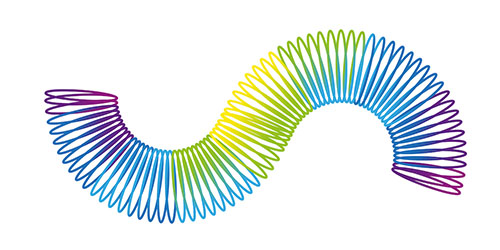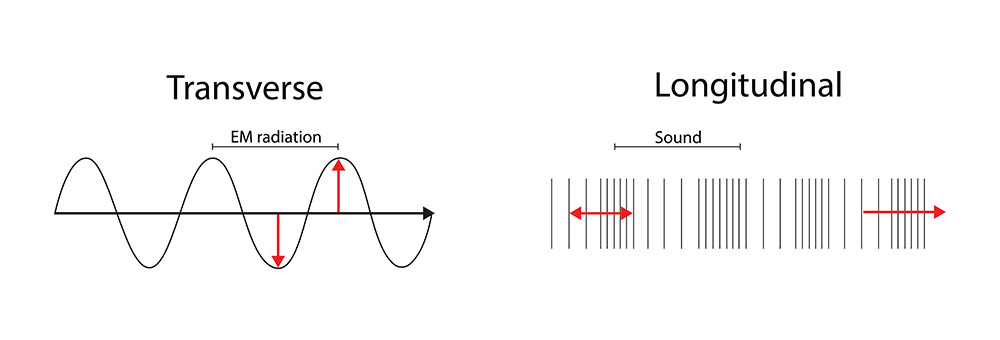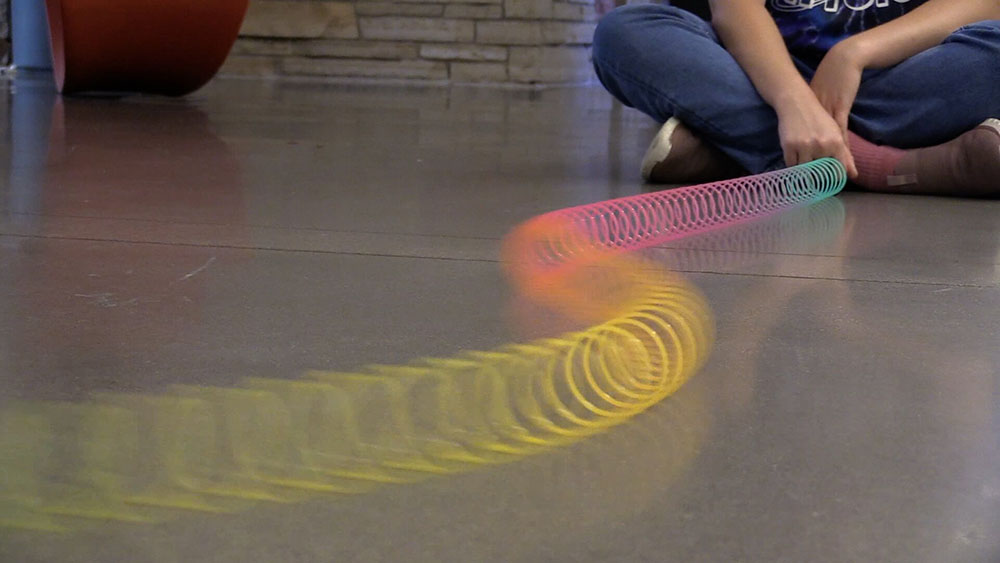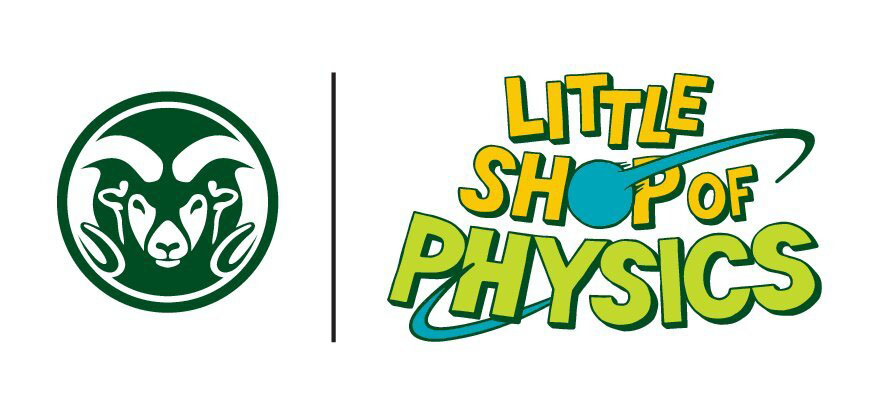Slinkys
Experimenting with wave properties
Total Time: 30 - 45 minutes
Audience: Middle School Science Teachers
Education Level: Grades 5 - 9
Content Area: Waves
Educational Topic: Waves, types of waves, features of waves, wave terminology
Objectives: In this lesson, students will experiment with Slinkys to learn about the different properties of waves and features that distinguish one wave from another. Students will use their observations to define wave terminology (transverse, longitudinal, standing waves, wavelength, frequency, medium) through exploration and experimentation of how waves move through a Slinky, then discuss formal definitions as a follow-up with the entire class. It is helpful to NOT preload students with this terminology and let them define for themselves before offering formal terms. See the Key Terms below for more guidance.
Key Question: What are the different properties of waves? What makes one wave different from another?

Next Generation Science Standards
MS-PS4-1. Use mathematical representations to describe a simple model for waves that includes how the amplitude of a wave is related to the energy in a wave.
4-PS4-1. Develop a model of waves to describe patterns in terms of amplitude and wavelength and that waves can cause objects to move.
MS-PS4-2. Develop and use a model to describe how waves are reflected, absorbed, or transmitted through various materials.
SEPs: Developing and Using Models ▪ Obtaining, Evaluating, and Communicating Information. (MS-PS4-1-2)
CCCs: Patterns ▪ Structure and Function
Materials
- One Slinky per group. Four to five students per group
- Long, smooth area on the floor in a gym or open hallway
Overview: Students start the lesson by discussing waves. This will provide teachers with formative assessment data to gauge students' prior knowledge of waves. Students will then engage in an experiment where they explore with Slinkys to answer the key question, “What are the different properties of waves? What makes one wave different from another?”
Teacher’s Guide
Teacher Background
Watch this video from Little Shop of Physics for an overview of the experimental setup and the science behind the phenomenon!
Slinkys are an easy and entertaining way to see, feel, and even hear key wave properties. They can be used to model two fundamental categories of waves: transverse and longitudinal. Mechanical waves need a medium to propagate in (as opposed to electromagnetic waves, which do not).
In this activity, the Slinky is the medium that the waves travel through. Waves carry energy, and cause points along the Slinky (the medium) to be displaced from their equilibrium positions in a predictable pattern. A longitudinal wave causes the Slinky to be displaced along the same axis that the wave is traveling in — it stretches and compresses the Slinky. Sound is an example of a longitudinal wave. Transverse waves, such as those that exist at the surfaces of oceans and lakes, are what most people think of when they think of waves: they cause the Slinky to be displaced along an axis that’s perpendicular to the one the wave is traveling in (side-to-side or up-and-down motion). Light and all electromagnetic waves are also examples of transverse waves.
When waves reach the far end of the Slinky, they will reflect and bounce back, interfering with any waves that might be traveling in the opposite direction. We will use this wave interference phenomenon to our advantage to create standing waves — waves that oscillate, but don’t change height (amplitude) or speed so they appear to be staying the same or “standing still” — so we can more easily observe wave properties like wavelength, frequency, and amplitude.


Key Terms (used or presented after the activities)
These are the key terms that students should know by the END of the two lessons. They do not need to be front loaded. In fact, studies show that presenting key terms to students before the lesson may not be as effective as having students observe and witness the phenomenon the key terms illustrate beforehand and learn the formalized words afterward. For this reason, we recommend allowing students to grapple with the experiments without knowing these words and then exposing them to the formalized definitions afterward in the context of what they learned.
However, if these words are helpful for students on an IEP, ELL students, or anyone else that may need more support, please use at your discretion.
- Wave: A disturbance that travels through a medium from one location to another, carrying energy as it goes.
- Medium: The material through which the wave propagates.
- Transverse wave: A wave in which the energy moves in a direction that’s perpendicular to the one that the wave is traveling along.
- Longitudinal wave: A wave that moves in the same direction that the wave is traveling along.
- Standing wave (also called stationary wave): Occurs when transverse waves traveling from opposite directions are of the same frequency and amplitude and interfere with each other in such a way as to make a pattern that appears to be standing still.
- Wavelength: The distance over which the wave shape repeats. For instance, the distance from one peak to the next peak in succession.
- Frequency: The number of waves that pass a fixed point in a certain amount of time.
- Amplitude: The height of the wave, determined from its centerline or equilibrium position.
Objectives
Students will experiment with Slinkys to learn about different types of waves, and features that distinguish one wave from another.*
*It is important to understand that student goals may be different and unique from the lesson goals. We recommend leaving room for students to set their own goals for each activity.
Before the Experiment
Watch this video from Little Shop of Physics for an overview of the experimental setup and the science behind the phenomenon!
Ask & Discuss
Why do you think waves might be important? How can understanding waves be useful? To whom are waves useful?
Pair students
- Give them one minute to think quietly.
- Give students two minutes to discuss their thinking.
- Have students record their answers or share out to the whole group.
Setting Up
- Make sure students are put into intentional groups. See foreword and STEP UP Everyday Actions Guide for more details. See Teacher Tips below.
- Group your students (groups of four to five work well) and give each group one Slinky.
- Stretch the Slinky out on a long, smooth floor area (avoid stretching the Slinky too tight; this could damage it).
- Test out wave-making techniques.
- Tip: Make longitudinal waves by keeping the slinky straight and pushing one end toward the other a few times.
- Make transverse waves by quickly pulling one end of the Slinky to the side with a sort of flicking motion, and making longitudinal waves by giving one end of the Slinky a sharp push forward push. Students may discover additional interesting techniques.
- Encourage students to observe thoughtfully, using multiple senses — this activity provides good tactile feedback on wave behavior. Make sure that students take turns being the wave-maker.
During the Experiment
Important Note: You can refer back to this activity as you learn more about waves. So be careful not to rush it! You’ll want students to have a solid understanding of how waves behave because they’ve experienced it kinesthetically first-hand! If they have the time to develop their terminology through their exploration they’ll remember it better in the long term.
Collecting Data
- Allow students to play with the Slinkys. After they play, get them started in making transverse and longitudinal waves. If students have learned the distinction between these two types of waves, they will often come up with solutions for creating each type with some gentle prompting. If they have yet to learn the difference, allowing them to play and describe the waves they can make can lead into a mini-lesson on each type.
- You can stop for a formative quiz here: What kind of wave (transverse or longitudinal) is performed by the crowd at baseball games? (transverse) What kind of wave is a sonic boom, made from a speedy aircraft traveling overhead? (Longitudinal)
- Once they understand the difference between longitudinal and transverse waves, take time to focus on transverse waves and their properties, because light is a transverse wave and we’ll be diving deeper into light in the next experiments.
- Have the student groups make only transverse waves with their Slinkys. If they have seen this vocab before, have each student group write: transverse, longitudinal, standing wave, wavelength, frequency, amplitude on their paper or whiteboards; if not, have them describe the ways they can change the wave and provide a mini-lesson defining the words after exploring.
- Can they make transverse waves of varying sizes? Speeds? Give them time to explore and invent ways to figure this out on their own.
- Have students draw pictures or write in words describing what each of the terms means.
- Walk around the room and hear the conversations between groups and help students develop their own ideas.
- Have students come together at the end to share their definitions of these wave terms.
Making Standing Waves (extension) - Ask students if they notice that the waves created from one end of the Slinky get reflected and will bounce back. These reflected waves can interfere with the waves made.
- If the waves sent out match the amplitude and frequency of the waves being reflected from the far end of the Slinky, you’ll end up creating a standing wave pattern — a wave that appears moving up and down, but not across the length of the Slinky.
- These standing waves occur at different frequencies, so it’s possible to make multiple “harmonics.” We’ve been able to create six different harmonics on this Slinky! Maybe your students will be able to shake the end of the Slinky fast enough to get to the seventh harmonic!
- For a visual of what these different harmonics look like, view the Physics Classroom' tutorial.
- Leveling Up Extension: A common misconception is that the first harmonic is one complete wave. But because it’s a crest (top of a wave) that oscillates and becomes a trough (bottom of a wave), over and over again, it’s only ever ½ of a full wave. You need a crest AND a trough at the same time to make one complete wave.
- 1st harmonic = ½ a wave
- 2nd harmonic = 1 wave
- 3rd harmonic = 1 ½ waves
- 4th harmonic = 2 waves
- 5th harmonic = 2 ½ waves
- And so on…
- Make sure the students rotate roles and everyone gets a chance at being the wave-maker. They will notice that if they shake the Slinky faster, you get more waves on the Slinky (a higher frequency of waves) and the waves are shorter in length and vice versa.
- You can use your smartphone or iPad for taking slow-motion videos, allowing students to take videos of their Slinky’s motion so they can record/stop/rewind and use this as a tool for discussion with their lab partners.
Important Note: Continue to listen in on each group’s discussion, answer as few questions as possible. Even if a group is off a little, they will have a chance to work out these stuck points later during discussion.
Teacher Tips
- A great way to start any physics related unit is with the STEP UP Careers in Physics lesson. This lesson covers careers one can do with a physics degree, particularly those that help solve societal problems. It helps students assess their personal values in relation to a career in physics, examine profiles of professionals with physics degrees, and envision themselves in a physics career.
- Suggested STEP UP Everyday Actions to incorporate into the activity:
- When pairing students, try to have male/female partners and invite female students to share their ideas first.
- As you put students into groups, consider having female or students from underrepresented backgrounds take the leadership role.
- Take note of female participation. If they seem to be only receiving direction and following along, elevate their voice by asking them a question about their experiment.
- Consider using whiteboards so students have time to work through their ideas and brainstorms before saying them out loud.
- As students experiment, roam around the room to listen in on discussion and notice experiment techniques. If needed, stop the class and call over to a certain group that has hit on an important concept.
- ***Consider using the RIP protocol (Research, Instruct, Plan) for lab group visits and conferring.
- ***Consider culturally responsive tools and strategies and/or open-ended reflection questions to help push student thinking, evidence tracking, and connections to their lives. Look for *** below to find suggested places to add.
Conclusion
- Mix the groups so that one student from each group is now paired with a student from another group. Have them write down an answer to the question: How would you describe what a wave is to someone who was absent from class today? Use all the terms from your whiteboard in your explanation.
- After students have had a chance to discuss key ideas from the lesson and complete their description of a wave, you can now clarify and give concise definitions of all the terminology they experimented with.
- Have students draw and describe when they saw waves with:
- Different amplitudes
- Different wavelengths
- What did you have to do to get the Slinky to change amplitude and wavelength? How do you think this relates to light waves?
- Introduce the PQ 23: Making Waves Physics Career and Concept Map and allow students to read through and discuss the careers that use this content. Extend their thinking with research about these careers if time allows.
Student’s Guide
Introduction
You’re probably aware that Slinkys are fun to play with! They can also help us understand different features and properties of waves. What comes to mind when you think of waves? You may think of ocean waves that crest and fall onto the beach. Or do you ever wonder how we hear music from the radio? Or how doctors can see skeletons when using X-ray machines? If you have wondered these or similar questions, then you are already thinking like a scientist.
In this activity, we are going to seek to understand two different kinds of waves: transverse and longitudinal. We’ll also learn about wave features. What distinguishes one wave from another? We’ll learn some new terminology as we go! So let’s grab some Slinkys, one per group, and start exploring!
Objective: Students will experiment with Slinkys to learn about different types of waves, and features that distinguish one wave from another.
Students: After reading the introduction, what is your essential question or objective for this activity?
Before the Experiment
Discuss
Why do you think waves might be important? How can understanding waves be useful? To whom are waves useful?
Setting Up
- Your group needs to work in an area with plenty of space! Find a space you can spread out (about 10 feet from one end of the Slinky to the other is ideal. Also make sure you have ample room away from walls or other structures so you can make waves on your Slinky).
- Station one or two people at each end of your Slinky so you have someone to talk to about what wave phenomenon you’re seeing, and what new discoveries you’re making.
- On a piece of paper or a whiteboard, write down the words: longitudinal, transverse, standing wave, wavelength, frequency, amplitude. You’ll experiment with the Slinky to understand each of these terms and then use pictures or words to show you understand what each of these words means.
During the Experiment***
Collecting Data
- Take some time to just play with the Slinkys, because Slinkys are pretty great. At some point, though, you’ll probably want to make transverse and longitudinal waves.
- Notice how both transverse and longitudinal waves carry energy from one person’s hand to the other — the wave moves through the Slinky in both cases.
- Demonstrate to your teacher that you know the difference between a transverse wave and a longitudinal wave, and that you know how to create both types of waves using the Slinky. Add what you know about longitudinal and transverse waves to your whiteboard. ______teacher initials
- Now, let’s take time to focus on transverse waves and their properties, because light shares some properties with transverse waves and we’ll be diving deeper into light in later experiments!
- Make only transverse waves with your Slinky. You’ve likely noticed that the waves created from one end of the Slinky get reflected and will bounce back. These reflected waves can interfere with the waves we are making. We are actually going to use this wave phenomenon to our advantage!
- If the waves you're sending out match the amplitude and frequency of the waves being reflected from the far end of the Slinky, you’ll end up creating a standing wave pattern — meaning the speed and amplitude aren’t changing and, therefore, it looks like the energy from the wave is moving the Slinky, but not moving from person to person. Try to make a standing wave pattern!
- Leveling Up Extension: These standing waves occur at different frequencies, so it’s possible to make different “harmonics.” We (at The Little Shop of Physics) have been able to create six different harmonics on this Slinky! Maybe your group will be able to shake the end of the Slinky fast enough to get to the seventh harmonic!
- For a visual of what these different harmonics look like, view the Physics Classroom's Tutorial.
- Leveling Up Extension: A common misconception is that the first harmonic is one complete wave. But because it’s a crest (top of a wave) that oscillates and becomes a trough (bottom of a wave), over and over again, it’s only ever ½ of a full wave. You need a crest AND a trough at the same time to make one complete wave.
- 1st harmonic = ½ a wave
- 2nd harmonic = 1 wave
- 3rd harmonic = ____ waves
- 4th harmonic = ____ waves
- 5th harmonic = ____ waves
- 6th harmonic = ____ waves
- 7th harmonic = were you really able to make this pattern?! Congrats if you did!
- Can you make transverse waves of varying lengths? Speeds? Take time to explore and invent ways to figure this out on your own.
- If available: Use a camera to film the waves so you can play back the video, pause, and rewind as needed. Try using slow-motion capture. Talk with your group mates about the wave phenomenon you’re seeing.
Analyzing Data
- Draw pictures or write in words describing what each of the terms on your whiteboard means. (See #3 in Setting Up)
- Demonstrate using the Slinky that you can create waves of various wavelengths.
- What happened to the frequency of the waves when the waves got longer?
- Be ready to discuss what you learned about these wave terms with others.
Conclusion***
- Discuss in groups: How would you describe what a wave is to someone who was absent from class today? Use all the terms from your whiteboard in your explanation.
- Use the Discussion Diamond protocol.
- The teacher poses a question that students can answer with data.
- All students get three minutes to think and write their thoughts in their respective corners.
- The students take turns explaining their ideas to each other (all students must share).
- The students discuss what their consensus view might be and write their consensus view in the middle.
- Explore the PQ 23: Making Waves Physics Career and Concept Map. What careers that use this content sound most appealing to you? Why?
Additional Resources
- https://www.physicsclassroom.com/mmedia/waves/gsl.cfm
- https://phet.colorado.edu/en/simulations/wave-on-a-string
- Sign up for Physicists To-Go to have a scientist talk to your students.
- STEP UP Women in Physics lesson: Introduces the underrepresentation of women in physics and the role of implicit bias and cultural stereotypes. Helps students examine the conditions for women in physics and helps students discuss gender issues, gendered professions, and personal experience to neutralize the effect of stereotypes and bias.
Assessment/Extension activities** (optional to extend thinking after the lesson):
- Real world connections:A guitar is an instrument that uses mechanical waves in order to produce music. Using what you learned in this lab, write a letter to a friend explaining how a guitar produces music. Feel free to include drawings and diagrams as well.
- Suggestions for drawing, illustrating, and presenting content in creative ways: Act out a wave as a class! You can act out waves with different wavelengths, frequencies, and amplitudes.
- Engineering and design challenges connected to the content:
**Real world situations/connections can be used as is, or changed to better fit a student’s own community and cultural context.
- When an earthquake occurs, mechanical waves move through the surface of the Earth. What could you build or design to prevent a building from being damaged? Be creative!
- If engineering challenges have a time constraint, students are allowed to keep iterating and developing their ideas outside of class time and continue to participate in the challenge at a later date.
- Watch this Listen to Light video and see what lasers sound like!
- When an earthquake occurs, mechanical waves move through the surface of the Earth. What could you build or design to prevent a building from being damaged? Be creative!
Credits

Reviewed by Summer Chrisman, MEd, Tamia Williams, MSt, Chris Irwin
Extensions by Jenna Tempkin
Formatted by Sierra Crandell, MEd, partially funded by Eucalyptus Foundation
PhysicsQuest © 2023 by American Physical Society is licensed under CC BY-NC 4.0
